Exotic
Adoxophyes orana (Fischer von Roslerstamm) (Tortricidae: Tortricinae: Archipini)
Common names: summer fruit tortrix, smaller tea tortrix, apple peel tortrix
Synonyms: minor (Archips), reticulana (Tortrix), sutschana (Capua), tripsiana (Tortrix)
Subspecies: A. orana beijingensis (China), A. orana fasciata (Japan), A. orana orana (Europe, China, Korea)
FWLFWL:
forewing length; the distance from the base of the forewing to the apex, including fringe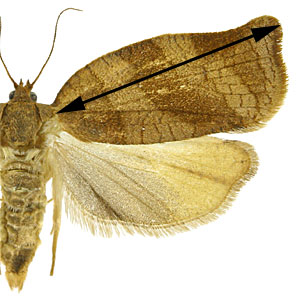 : 7.0-8.5 mm (males); 8.0-11.0 mm (females)
: 7.0-8.5 mm (males); 8.0-11.0 mm (females)
Forewings are pale yellowish brown with brown to dark brown fasciatefasciate:
a wing pattern that is comprised primarily of transverse bands (fasciae) 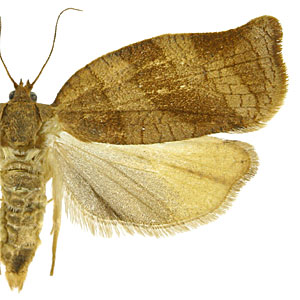 markings. Males are smaller with brighter markings and a forewing costal foldforewing costal fold:
markings. Males are smaller with brighter markings and a forewing costal foldforewing costal fold:
a flap or fold at the base of the forewing that contains specialized sex scales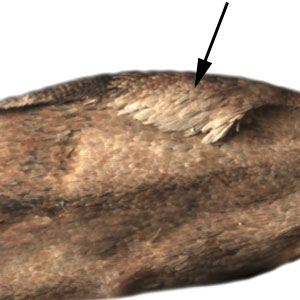 ; females are larger, darker, and have duller markings.
; females are larger, darker, and have duller markings.
Male genitalia are characterized by reduced sociisocii:
a pair of lightly sclerotized setose lobes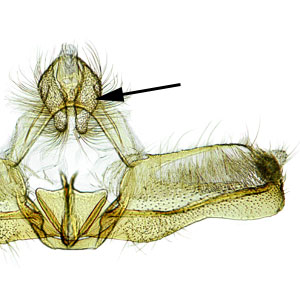 , a well-developed gnathosgnathos:
, a well-developed gnathosgnathos:
a narrow bandlike structure that joins the posterolateral edges of the tegumen and supports the anal tube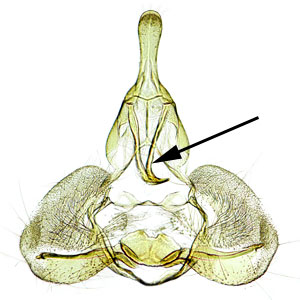 , a rounded valvavalva:
, a rounded valvavalva:
an appendage flanking the intromittent organ that is used to clasp the female during copulation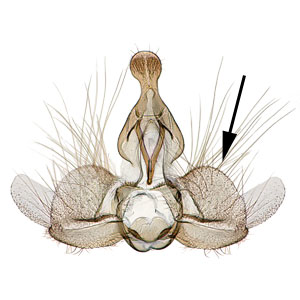 , and transtilla with a spiny basal lobe. Female genitalia have a long ductus bursaeductus bursae:
, and transtilla with a spiny basal lobe. Female genitalia have a long ductus bursaeductus bursae:
a membranous tube connecting the ostium bursae to the corpus bursae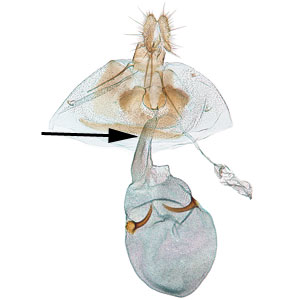 and a hook-like signumsignum:
and a hook-like signumsignum:
a sclerotized projection or patch on the interior of the corpus bursae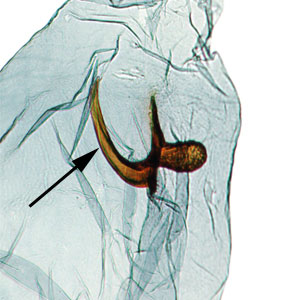 near the base of the corpus bursaecorpus bursae:
near the base of the corpus bursaecorpus bursae:
a dilated membranous sac at the anterior end of the bursa copulatrix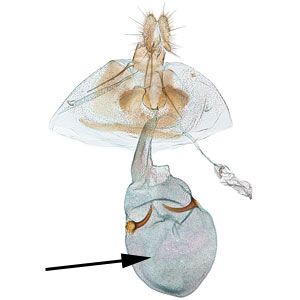 .
.
Detailed descriptions of larval chaetotaxychaetotaxy:
the arrangement of setae (in reference to Lepidoptera larvae), often depicted on a "setal map"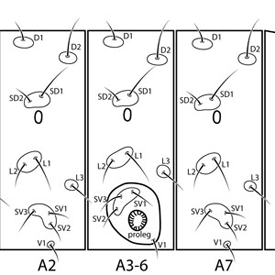 are unavailable for A. orana. The following account is summarized from Sakamaki & Hayakawa (2004).
are unavailable for A. orana. The following account is summarized from Sakamaki & Hayakawa (2004).
Last instar larvae vary in body color. The head and prothoracic shieldprothoracic shield:
a sclerotized plate on the dorsal surface of the prothorax 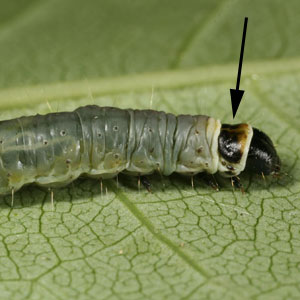 are black in early instars and become brown to yellowish brown in later instars. Legs are unmarked.
are black in early instars and become brown to yellowish brown in later instars. Legs are unmarked.
Adult Adoxophyes orana may appear similar to other Adoxophyes and species in other genera such as Choristoneura and Clepsis. Adoxophyes in Asia include: A. dubia (Japan), A. honmai (Japan and Korea), A. orana beijingensis (China), A. orana fasciata (Japan), A. orana orana (China, Korea, and Europe), and A. privatana (China). All are difficult to separate using morphology and molecular diagnostics may be required for a positive identification (see Lee et al. 2005Lee et al. 2005:
Lee, S. Y., Park, H., Boo, K. S., Park, K.-T., Cho, S. 2005. Molecular identification of Adoxophyes honmai (Yasuda) (Lepidoptera: Tortricidae) based on mitochondrial COI gene sequences. Molecules and Cells. 19: 391-397.).
Larvae appear similar to those of many other tortricids, including Choristoneura rosaceana, Epiphyas postvittana, and many Archipini. Molecular diagnostics may be required to positively identify A. orana larvae. Sakamaki & Hayakawa (2004) attempted to separate the immature stages of the three Japanese Adoxophyes using morphology but the differences they found are too minor to be diagnostic.
The following account is summarized from Tamaki (1991)Tamaki (1991):
Tamaki, Y. 1991. Tortricids in tea, pp. 541-551. In : van der Geest , L. P. S., Evenhuis, H. H. (eds.), Tortricid Pests: Their Biology, Natural Enemies, and Control. World Crop Pests, Vol. 5. Elsevier, Amsterdam. and Yasuda (1998)Yasuda (1998):
Yasuda, T. 1998. The Japanese species of the genus Adoxophyes Meyrick (Lepidoptera, Tortricidae). Transactions of the Lepidopterological Society of Japan. 49: 159-173..
Adoxophyes orana completes 2-3 generations per year. Adults are present in late May and June for the first generation, in July through September for the second generation, and in October for the third generation. Flight times vary with latitude and climatic conditions. Females lay eggs in masses of 4-150 individual eggs. Eggs are laid primarily on leaves, but females may utilize fruits and tree trunks in outbreak conditions. First instar larvae hatch in 8-20 days and feed under a silk web on the underside of a leaf. Later instars feed inside rolled leaves or web leaves to fruit and feed on the surface. Larvae complete five instars and pupation occurs in the final larval nest. Second or third instar larvae of the last generation hibernate until spring and complete development by feeding on buds and young leaves.
This species is considered a major pest of fruit crops throughout its range. Most economic loss is caused by damage to apple and pear. Adoxophyes orana is highly polyphagous and larvae have been recorded feeding on the leaves and fruits of plants in many different families.
Although tea (Camellia sinensis) is listed in the table below as a host for A. orana, it is questionable if this record refers to the same species of Adoxophyes. Zhou et al. (1997) determined that the fruit-feeding populations of A. orana in northern China were a different subspecies (A. orana beijingensis) than the cotton- and tea-feeding populations in southern China (A. orana orana). In Japan, A. orana has long been divided into an “apple form” and “tea form,” referring to populations that utilize different hosts. Yasuda (1998)Yasuda (1998):
Yasuda, T. 1998. The Japanese species of the genus Adoxophyes Meyrick (Lepidoptera, Tortricidae). Transactions of the Lepidopterological Society of Japan. 49: 159-173. described the “tea form” of Adoxophyes in Japan as a new species, Adoxophyes honmai, and treated the “apple form” of A. orana in Japan as a new subspecies (A. orana fasciata). Tea-feeding Adoxophyes in Korea were determined to also be A. honmai using molecular methods (Lee et al. 2005Lee et al. 2005:
Lee, S. Y., Park, H., Boo, K. S., Park, K.-T., Cho, S. 2005. Molecular identification of Adoxophyes honmai (Yasuda) (Lepidoptera: Tortricidae) based on mitochondrial COI gene sequences. Molecules and Cells. 19: 391-397.). It is unknown if the Chinese tea-feeding A. orana orana is actually a separate species or if it is conspecific with A. honmai.
| Host plant | Host plant family | Reference(s) |
| Acer campestre | Aceraceae | Janssen 1958Janssen 1958: Janssen, M. 1958. Uuml;ber Biologie, Massenwechsel und Bekauml;mpfung von Adoxophyes orana Fischer von Roeslerstamm (Lepidoptera: Tortricidae). Beitrauml;ge zur Entomologie 8(3-4): 291-324.; Balachowsky 1966Balachowsky 1966: Balachowsky, A.S. 1966. Entomologie appliquée à l'agriculture. Tome II. Lépidoptères. Masson et Cie editeurs, Paris. ; Barel 1973Barel 1973: Barel, C. J. A. 1973. Studies on the dispersal of Adoxophyes orana F.v.R. in relation to the population sterilization technique. Mededelingen Landbouwhogeschool, Veenman, Wageningen.; Whittel 1985 |
| Acer sp. | Aceraceae | de Jong et al. 1071 |
| Pistacia lentiscus | Anacardiaceae | Janssen 1958Janssen 1958: Janssen, M. 1958. Uuml;ber Biologie, Massenwechsel und Bekauml;mpfung von Adoxophyes orana Fischer von Roeslerstamm (Lepidoptera: Tortricidae). Beitrauml;ge zur Entomologie 8(3-4): 291-324.; Balaqchowsky 1966; Barel 1973Barel 1973: Barel, C. J. A. 1973. Studies on the dispersal of Adoxophyes orana F.v.R. in relation to the population sterilization technique. Mededelingen Landbouwhogeschool, Veenman, Wageningen.; Whittle 1985Whittle 1985: Whittle, K. 1985. Pests not known to occur in the United States or of limited distribution, no. 62: summer fruit tortrix moth. USDA pest detection guides.; BMNH collectionBMNH collection: BMNH collection. Based on identified reared specimens in the collection of The Natural History Museum, London; identifications by staff of the Lepidoptera Section. |
| Pistacia sp. | Anacardiaceae | Savopoulou-Soultani et al. 1985Savopoulou-Soultani et al. 1985: Savopoulou-Soultani, M., Hatzivassiliadis, A., Vlug, H. J., Minks, A. K., Tzanakakis, M. E. 1985. First records of the summerfruit tortricid, Adoxophyes orana F. v. R. in Greece. Entomologica Hellenica. 3: 65-66. |
| Alnus glutinosa | Betulaceae | Bradley et al. 1973Bradley et al. 1973: Bradley, J. D., Tremewan, W. G., Smith, A. 1973. British Tortricoid Moths, Cochylidae and Tortricidae: Tortricinae. The Ray Society, London. 251 pp.; Jaros & Spitzer 2002 |
| Alnus sp. | Betulaceae | Janssen 1958Janssen 1958: Janssen, M. 1958. Uuml;ber Biologie, Massenwechsel und Bekauml;mpfung von Adoxophyes orana Fischer von Roeslerstamm (Lepidoptera: Tortricidae). Beitrauml;ge zur Entomologie 8(3-4): 291-324.; Balachowsky 1966Balachowsky 1966: Balachowsky, A.S. 1966. Entomologie appliquée à l'agriculture. Tome II. Lépidoptères. Masson et Cie editeurs, Paris. ; de jong et al. 1971de Jong et al. 1971: de Jong, D. J., Ankersmit, G. W., Barel, C. J. A., Minks, A. K. 1971. Summer fruit tortrix moth, Adoxophyes orana F.R.: Studies on biology, behavior, and population dynamics in relation to the application of the sterility principle. pp. 27-39. In : Proceedings, Proceedings of a panel on the Application of Induced Sterility for Control of Lepidopterous Populations, organized by the joint FAO/IAEA Division of Atomic Energy in Food and Agriculture, 1-5 June, 1970, Vienna.; Whittel 1985; Choong DB 1996Choong DB 1996: Choong DB. 1996. Food plant data base and personal communications from Choong (Gaeden Robinson Database - BMNH). |
| Betula sp. | Betulaceae | Meyrick MS 1938Meyrick MS 1938: Meyrick MS 1938. Unpublished manuscript by E. Meyrick at BMNH, data captured by Gaeden Robinson.; Janssen 1958Janssen 1958: Janssen, M. 1958. Uuml;ber Biologie, Massenwechsel und Bekauml;mpfung von Adoxophyes orana Fischer von Roeslerstamm (Lepidoptera: Tortricidae). Beitrauml;ge zur Entomologie 8(3-4): 291-324.; Balachowsky 1966Balachowsky 1966: Balachowsky, A.S. 1966. Entomologie appliquée à l'agriculture. Tome II. Lépidoptères. Masson et Cie editeurs, Paris. ; de Jong et al. 1971de Jong et al. 1971: de Jong, D. J., Ankersmit, G. W., Barel, C. J. A., Minks, A. K. 1971. Summer fruit tortrix moth, Adoxophyes orana F.R.: Studies on biology, behavior, and population dynamics in relation to the application of the sterility principle. pp. 27-39. In : Proceedings, Proceedings of a panel on the Application of Induced Sterility for Control of Lepidopterous Populations, organized by the joint FAO/IAEA Division of Atomic Energy in Food and Agriculture, 1-5 June, 1970, Vienna.; Bradley et al. 1973Bradley et al. 1973: Bradley, J. D., Tremewan, W. G., Smith, A. 1973. British Tortricoid Moths, Cochylidae and Tortricidae: Tortricinae. The Ray Society, London. 251 pp.; Whittle 1985Whittle 1985: Whittle, K. 1985. Pests not known to occur in the United States or of limited distribution, no. 62: summer fruit tortrix moth. USDA pest detection guides. |
| Carpinus betulus | Betulaceae | Janssen 1958Janssen 1958: Janssen, M. 1958. Uuml;ber Biologie, Massenwechsel und Bekauml;mpfung von Adoxophyes orana Fischer von Roeslerstamm (Lepidoptera: Tortricidae). Beitrauml;ge zur Entomologie 8(3-4): 291-324.; Blachowsky 1966; Barel 1973Barel 1973: Barel, C. J. A. 1973. Studies on the dispersal of Adoxophyes orana F.v.R. in relation to the population sterilization technique. Mededelingen Landbouwhogeschool, Veenman, Wageningen.; Whittle 1985Whittle 1985: Whittle, K. 1985. Pests not known to occur in the United States or of limited distribution, no. 62: summer fruit tortrix moth. USDA pest detection guides. |
| Carpinus sp. | Betulaceae | de Jong et al. 1971de Jong et al. 1971: de Jong, D. J., Ankersmit, G. W., Barel, C. J. A., Minks, A. K. 1971. Summer fruit tortrix moth, Adoxophyes orana F.R.: Studies on biology, behavior, and population dynamics in relation to the application of the sterility principle. pp. 27-39. In : Proceedings, Proceedings of a panel on the Application of Induced Sterility for Control of Lepidopterous Populations, organized by the joint FAO/IAEA Division of Atomic Energy in Food and Agriculture, 1-5 June, 1970, Vienna. |
| Corylus avellana | Betulaceae | Bradley et al. 1973Bradley et al. 1973: Bradley, J. D., Tremewan, W. G., Smith, A. 1973. British Tortricoid Moths, Cochylidae and Tortricidae: Tortricinae. The Ray Society, London. 251 pp. |
| Corylus sp. | Betulaceae | Whittle 1985Whittle 1985: Whittle, K. 1985. Pests not known to occur in the United States or of limited distribution, no. 62: summer fruit tortrix moth. USDA pest detection guides.; Choong DB 1996Choong DB 1996: Choong DB. 1996. Food plant data base and personal communications from Choong (Gaeden Robinson Database - BMNH). |
| Humulus lupulus | Cannabaceae | Bradley et al. 1973Bradley et al. 1973: Bradley, J. D., Tremewan, W. G., Smith, A. 1973. British Tortricoid Moths, Cochylidae and Tortricidae: Tortricinae. The Ray Society, London. 251 pp.; Jaros & Spitzer 2002 |
| Humulus sp. | Cannabaceae | Janssen 1958Janssen 1958: Janssen, M. 1958. Uuml;ber Biologie, Massenwechsel und Bekauml;mpfung von Adoxophyes orana Fischer von Roeslerstamm (Lepidoptera: Tortricidae). Beitrauml;ge zur Entomologie 8(3-4): 291-324.; Balachowsky 1966Balachowsky 1966: Balachowsky, A.S. 1966. Entomologie appliquée à l'agriculture. Tome II. Lépidoptères. Masson et Cie editeurs, Paris. ; Barel 1973Barel 1973: Barel, C. J. A. 1973. Studies on the dispersal of Adoxophyes orana F.v.R. in relation to the population sterilization technique. Mededelingen Landbouwhogeschool, Veenman, Wageningen.; Whittle 1985Whittle 1985: Whittle, K. 1985. Pests not known to occur in the United States or of limited distribution, no. 62: summer fruit tortrix moth. USDA pest detection guides.; Choong DB 1996Choong DB 1996: Choong DB. 1996. Food plant data base and personal communications from Choong (Gaeden Robinson Database - BMNH). |
| Lonicera caprifolium | Caprifoliaceae | Janssen 1958Janssen 1958: Janssen, M. 1958. Uuml;ber Biologie, Massenwechsel und Bekauml;mpfung von Adoxophyes orana Fischer von Roeslerstamm (Lepidoptera: Tortricidae). Beitrauml;ge zur Entomologie 8(3-4): 291-324.; Balachowsky 1966Balachowsky 1966: Balachowsky, A.S. 1966. Entomologie appliquée à l'agriculture. Tome II. Lépidoptères. Masson et Cie editeurs, Paris. ; Barel 1973Barel 1973: Barel, C. J. A. 1973. Studies on the dispersal of Adoxophyes orana F.v.R. in relation to the population sterilization technique. Mededelingen Landbouwhogeschool, Veenman, Wageningen.; Whittle 1985Whittle 1985: Whittle, K. 1985. Pests not known to occur in the United States or of limited distribution, no. 62: summer fruit tortrix moth. USDA pest detection guides. |
| Lonicera periclymenum | Caprifoliaceae | Bradley et al. 1973Bradley et al. 1973: Bradley, J. D., Tremewan, W. G., Smith, A. 1973. British Tortricoid Moths, Cochylidae and Tortricidae: Tortricinae. The Ray Society, London. 251 pp. |
| Lonicera sp. | Caprifoliaceae | Meyrick MS 1938Meyrick MS 1938: Meyrick MS 1938. Unpublished manuscript by E. Meyrick at BMNH, data captured by Gaeden Robinson.; de Jong et al. 1971de Jong et al. 1971: de Jong, D. J., Ankersmit, G. W., Barel, C. J. A., Minks, A. K. 1971. Summer fruit tortrix moth, Adoxophyes orana F.R.: Studies on biology, behavior, and population dynamics in relation to the application of the sterility principle. pp. 27-39. In : Proceedings, Proceedings of a panel on the Application of Induced Sterility for Control of Lepidopterous Populations, organized by the joint FAO/IAEA Division of Atomic Energy in Food and Agriculture, 1-5 June, 1970, Vienna.; Savopoulou-Soultani et al. 1985Savopoulou-Soultani et al. 1985: Savopoulou-Soultani, M., Hatzivassiliadis, A., Vlug, H. J., Minks, A. K., Tzanakakis, M. E. 1985. First records of the summerfruit tortricid, Adoxophyes orana F. v. R. in Greece. Entomologica Hellenica. 3: 65-66. |
| Lonicera xylosteum | Caprifoliaceae | Janssen 1958Janssen 1958: Janssen, M. 1958. Uuml;ber Biologie, Massenwechsel und Bekauml;mpfung von Adoxophyes orana Fischer von Roeslerstamm (Lepidoptera: Tortricidae). Beitrauml;ge zur Entomologie 8(3-4): 291-324.; Balachowsky 1966Balachowsky 1966: Balachowsky, A.S. 1966. Entomologie appliquée à l'agriculture. Tome II. Lépidoptères. Masson et Cie editeurs, Paris. ; Barel 1973Barel 1973: Barel, C. J. A. 1973. Studies on the dispersal of Adoxophyes orana F.v.R. in relation to the population sterilization technique. Mededelingen Landbouwhogeschool, Veenman, Wageningen.; Whittle 1985Whittle 1985: Whittle, K. 1985. Pests not known to occur in the United States or of limited distribution, no. 62: summer fruit tortrix moth. USDA pest detection guides. |
| Symphoricarpos albus | Caprifoliaceae | Janssen 1958Janssen 1958: Janssen, M. 1958. Uuml;ber Biologie, Massenwechsel und Bekauml;mpfung von Adoxophyes orana Fischer von Roeslerstamm (Lepidoptera: Tortricidae). Beitrauml;ge zur Entomologie 8(3-4): 291-324.; Barel 1973Barel 1973: Barel, C. J. A. 1973. Studies on the dispersal of Adoxophyes orana F.v.R. in relation to the population sterilization technique. Mededelingen Landbouwhogeschool, Veenman, Wageningen.; Whittle 1985Whittle 1985: Whittle, K. 1985. Pests not known to occur in the United States or of limited distribution, no. 62: summer fruit tortrix moth. USDA pest detection guides. |
| Chenopodium album | Chenopodiaceae | Barel 1973Barel 1973: Barel, C. J. A. 1973. Studies on the dispersal of Adoxophyes orana F.v.R. in relation to the population sterilization technique. Mededelingen Landbouwhogeschool, Veenman, Wageningen. |
| Convolvulus arvensis | Convolvulaceae | Barel 1973Barel 1973: Barel, C. J. A. 1973. Studies on the dispersal of Adoxophyes orana F.v.R. in relation to the population sterilization technique. Mededelingen Landbouwhogeschool, Veenman, Wageningen. |
| Diospyros kaki | Ebenaceae | Choong DB 1996Choong DB 1996: Choong DB. 1996. Food plant data base and personal communications from Choong (Gaeden Robinson Database - BMNH). |
| Rhododendron catawbiensse | Ericaceae | Fluckiger & Benz 1982 |
View full screen host table here
This species is widely distributed throughout Europe and several countries in Asia (China, Japan, and Korea).